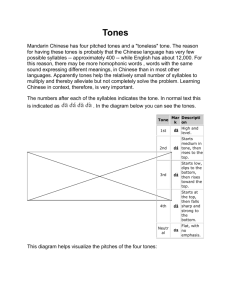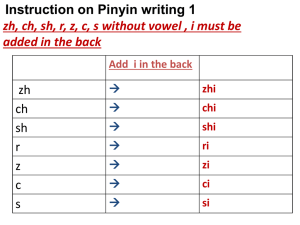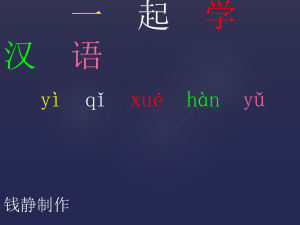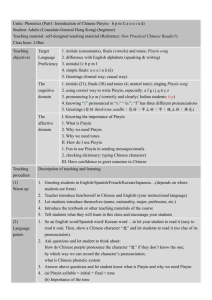Learning a Tonal Language by Attending to the Tone
advertisement
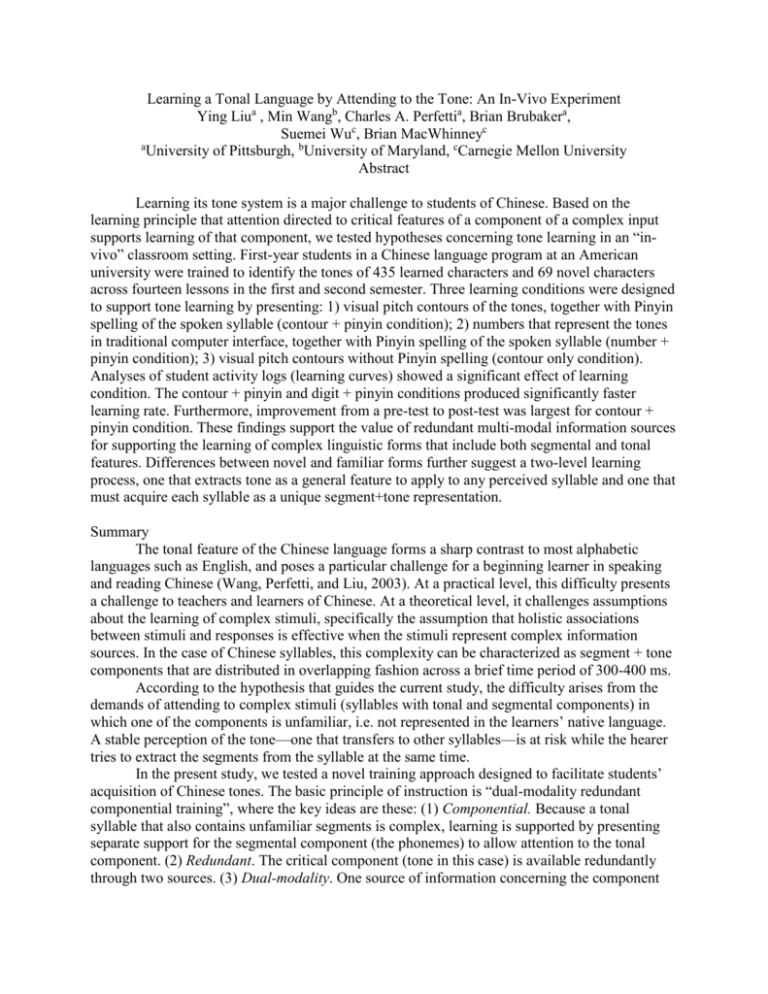
Learning a Tonal Language by Attending to the Tone: An In-Vivo Experiment Ying Liua , Min Wangb, Charles A. Perfettia, Brian Brubakera, Suemei Wuc, Brian MacWhinneyc a University of Pittsburgh, bUniversity of Maryland, cCarnegie Mellon University Abstract Learning its tone system is a major challenge to students of Chinese. Based on the learning principle that attention directed to critical features of a component of a complex input supports learning of that component, we tested hypotheses concerning tone learning in an “invivo” classroom setting. First-year students in a Chinese language program at an American university were trained to identify the tones of 435 learned characters and 69 novel characters across fourteen lessons in the first and second semester. Three learning conditions were designed to support tone learning by presenting: 1) visual pitch contours of the tones, together with Pinyin spelling of the spoken syllable (contour + pinyin condition); 2) numbers that represent the tones in traditional computer interface, together with Pinyin spelling of the spoken syllable (number + pinyin condition); 3) visual pitch contours without Pinyin spelling (contour only condition). Analyses of student activity logs (learning curves) showed a significant effect of learning condition. The contour + pinyin and digit + pinyin conditions produced significantly faster learning rate. Furthermore, improvement from a pre-test to post-test was largest for contour + pinyin condition. These findings support the value of redundant multi-modal information sources for supporting the learning of complex linguistic forms that include both segmental and tonal features. Differences between novel and familiar forms further suggest a two-level learning process, one that extracts tone as a general feature to apply to any perceived syllable and one that must acquire each syllable as a unique segment+tone representation. Summary The tonal feature of the Chinese language forms a sharp contrast to most alphabetic languages such as English, and poses a particular challenge for a beginning learner in speaking and reading Chinese (Wang, Perfetti, and Liu, 2003). At a practical level, this difficulty presents a challenge to teachers and learners of Chinese. At a theoretical level, it challenges assumptions about the learning of complex stimuli, specifically the assumption that holistic associations between stimuli and responses is effective when the stimuli represent complex information sources. In the case of Chinese syllables, this complexity can be characterized as segment + tone components that are distributed in overlapping fashion across a brief time period of 300-400 ms. According to the hypothesis that guides the current study, the difficulty arises from the demands of attending to complex stimuli (syllables with tonal and segmental components) in which one of the components is unfamiliar, i.e. not represented in the learners’ native language. A stable perception of the tone—one that transfers to other syllables—is at risk while the hearer tries to extract the segments from the syllable at the same time. In the present study, we tested a novel training approach designed to facilitate students’ acquisition of Chinese tones. The basic principle of instruction is “dual-modality redundant componential training”, where the key ideas are these: (1) Componential. Because a tonal syllable that also contains unfamiliar segments is complex, learning is supported by presenting separate support for the segmental component (the phonemes) to allow attention to the tonal component. (2) Redundant. The critical component (tone in this case) is available redundantly through two sources. (3) Dual-modality. One source of information concerning the component comes from spoken input and one comes from visual input. These three aspects of the training are designed to draw the learner’s attention to the critical features of a syllabic tone. The dual modality feature allows the learner to attend specifically to a visual representation of tone and to extract critical tonal contour information, adding it the representation of syllable phonology. To test training schedules that implement this idea to different degrees, we designed three training conditions in which we trained students to perceive tones using: 1) visual pitch contours that depict the acoustic information of the tones, together with Pinyin spelling of the spoken syllable; 2) numbers that represent the tones, together with Pinyin spelling of the spoken syllable; 3) visual pitch contours, without Pinyin spelling. Condition 1 implements the instructional principle fully; condition 2 lacks the dual modality feature; condition 3 lacks the redundancy provided by the pinyin spelling. By comparing the above three training conditions, we test two hypotheses: 1) providing separate support for syllable segments through Pinyin spelling, attention to tonal information and this tonal learning will be enhanced. 2) providing a visual representation of a tonal pitch contour will support the representation of rapid pitch shifts that are critical for tone perception, and this facilitate tonal learning. The study is part of a larger foreign language learning project associated with the Pittsburgh Science of Learning Center (PSLC). An in-vivo experimentation paradigm was used with curriculum vocabulary as training materials. We tracked students learning in eight lessons across the first semester. In-vivo experimentation is an ecologically valid tool to study changes that occur in actually classrooms during an actual course. It produces results that survive rigorous experimentation with laboratory-quality methods in real classroom settings. Such experimentation will focus on robust learning, that is, learning that is retained over long durations, transfers to novel situations, and accelerates future learning (Aleven & Koedinger, 2002). Using this unique research paradigm, we aimed to test learning hypotheses based on the assumption that attending to the critical features of the Chinese tone facilitates learning. Students enrolled in their first year of an introductory Chinese language course at Carnegie Mellon University (CMU) participated in this study. They were instructed to go through the online tone training program once a week right after the classroom instruction. The online training programs were developed using Cognitive Tutoring Authoring Tools (Koedinger, Aleven, Heffernan, McLaren, & Hockenberry, 2004). The audio stimuli were digitally recorded by a Chinese language instructor at the Modern Languages department of CMU. When using the tutor, students went through the word one by one. First they listened to the recorded audio of a mono- or bi-syllabic word, which was the same across three conditions. Then simultaneously, they viewed on the computer screen a different interface according to the condition (class) there were assigned. All students were asked to click on one of the five answer buttons representing the five possible tones: Tone1, Tone2, Tone3, Tone4, and neutral tone. In the case of bi-syllable words, two sets of buttons were provided for the two syllables, see Figure 1. The third-tone answer-button in for a second syllable included the label ‘(or half)’ in order to account for tone sandhi alterations when two third tone patterns are combined in one bi-syllable word. One important characteristic of the PSLC’s in-vivo paradigm is the use of log-files that contain trial-by-trial data that can reflect the online learning process. By analyzing the log files with non-linear regression and three tests (one pre-test and two post-tests) with ANOVA, we obtained evidence for the effect of utilizing pinyin and visual information in learning tone – a unique phonological feature of a tonal language. The results showed that beginning Chinese learners produced a higher learning rate in detecting tones of the syllables when trained with Pinyin spellings. When Pinyin was coupled with visual pitch contour, the beginning learners also showed better improvement in their tone judgment performance from pre-test to post-test. However, novel syllables still posted a challenge to students even in the second semester, new studies are being designed to explore this issue. The present study showed that in-vivo experimentation is a useful tool for testing robust learning factors in second language learning, and lead to findings and conclusions that can be more directly applied to real life teaching environment. Aleven, V., & Koedinger, K. R. (2002). An effective meta-cognitive strategy: Learning by doing and explaining with a computer-based Cognitive Tutor. Cognitive Science, 26(2), 147–179. Koedinger, K. R., Aleven, V., Heffernan. T., McLaren, B. & Hockenberry, M. (2004). Opening the Door to Non-Programmers: Authoring Intelligent Tutor Behavior by Demonstration. In the Proceedings of 7th Annual Intelligent Tutoring Systems Conference. Maceio, Brazil. Wang, M., Perfetti, C. A., & Liu, Y. (2003). Alphabetic readers quickly acquire orthographic structure in learning to read Chinese. Scientific Studies in Reading, 72(2), 183-207.

